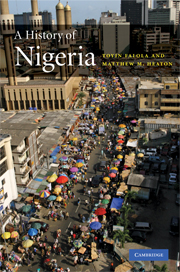Book contents
- Frontmatter
- Contents
- List of illustrations
- List of maps
- Acknowledgments
- Chronology
- Notable people in Nigerian history
- List of abbreviations
- Glossary
- Map 1 Major cities and ethnic groups in present-day Nigeria
- Introduction
- 1 Early states and societies, 9000 BCE – 1500 CE
- 2 Slavery, state, and society, c. 1500 – c. 1800
- 3 Political and economic transformations in the nineteenth century
- 4 Transition to British colonial rule, 1850 – 1903
- 5 Colonial society to 1929
- 6 Nationalist movements and independence, 1929 – 1960
- 7 Instability and civil war, 1960 – 1970
- 8 Oil, state, and society, 1970 – 1983
- 9 Civil society and democratic transition, 1984 – 2007
- 10 Nigeria and Nigerians in world history
- Concluding remarks: corruption, anti-corruption, and the 2007 elections
- Notes
- Selected bibliography
- Index
2 - Slavery, state, and society, c. 1500 – c. 1800
Published online by Cambridge University Press: 05 June 2012
- Frontmatter
- Contents
- List of illustrations
- List of maps
- Acknowledgments
- Chronology
- Notable people in Nigerian history
- List of abbreviations
- Glossary
- Map 1 Major cities and ethnic groups in present-day Nigeria
- Introduction
- 1 Early states and societies, 9000 BCE – 1500 CE
- 2 Slavery, state, and society, c. 1500 – c. 1800
- 3 Political and economic transformations in the nineteenth century
- 4 Transition to British colonial rule, 1850 – 1903
- 5 Colonial society to 1929
- 6 Nationalist movements and independence, 1929 – 1960
- 7 Instability and civil war, 1960 – 1970
- 8 Oil, state, and society, 1970 – 1983
- 9 Civil society and democratic transition, 1984 – 2007
- 10 Nigeria and Nigerians in world history
- Concluding remarks: corruption, anti-corruption, and the 2007 elections
- Notes
- Selected bibliography
- Index
Summary
INTRODUCTION
This chapter focuses on the formation and consolidation of states in the Nigerian area from the sixteenth through eighteenth centuries AD. During this period, large, centralized states built upon strong agrarian bases, generating surpluses that allowed for economic diversification and engagement in regional and international trade. One such diversification was the growth of an international trade in slaves, particularly out of the south. This chapter emphasizes the role that slavery and the slave trade played in social relations and in the establishment and consolidation of political power in states throughout the Nigerian region. It is important to note that slavery and the slave trade were not the main factors in the formation of these states, most of which existed in one form or another before the arrival of European traders on the coasts in the late fifteenth century. From the 1500s through the 1800s, however, the trade in slaves did provide important sources of revenue and access to items such as guns and European luxury goods that contributed greatly to the consolidation of wealth and power in many states. In the states of the northern savannas and the Sahel, the institution of slavery had deep roots, and connections with the trans-Saharan trade routes meant that markets for slave exports had existed for several centuries. As the main trans-Saharan trade routes moved east in the fifteenth and sixteenth centuries, coinciding with the expansion and consolidation of the Hausa states and the Borno empire, tensions between these states mounted.
- Type
- Chapter
- Information
- A History of Nigeria , pp. 39 - 60Publisher: Cambridge University PressPrint publication year: 2008



